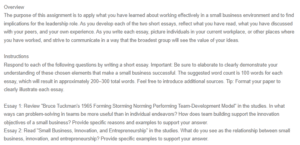Small Business Enterprise Reflections
The article emphasizes that entrepreneurs, small organizations, and innovation are interrelated in today’s business environment. The authors assert that small businesses are formed from the desire of capitalists to own factors of production, which also births entrepreneurship. For the article, entrepreneurs then acquire their status because they have successfully started small businesses that are used as premises to produce goods and services for sale. Production of these goods and services may require the entrepreneur to invest capital to purchase raw materials for production or hire labour to provide services. Further, setting up a small business requires that the entrepreneur sources for a premise, which is characterized as land under the factors of production. In this way, the entrepreneur owning a small business successfully embodies the capitalist and fulfills the sole desire of this economist.
However, for a small business to operate successfully, it is essential to be innovative so that it satisfies its customers. This approach also ensures it remains operational in the long term. Many organizations use a standardized strategy to produce goods and services, which dissatisfies many customers who wish to have a variety of products that satisfy their distinctive needs and wants. For a small business to compete successfully in the business context today, it is essential to use innovation to create internal processes that result in the production of unique goods and services that clients have not experienced before (Sahut & Peris-Ortiz, 2014). A small business owned by an entrepreneur can use innovation successfully to capture competitors’ clients because of unique goods and services produced using the above approach are high in today’s competitive business environment. The explanation above proves that small businesses, innovation, and entrepreneurship are related concepts.
References
Chapman, A. (2021, February 17). Tuckman: Forming, Storming, Norming, Performing model. Leadership and Management Training – BusinessBalls.com. https://www.businessballs.com/team-management/tuckman-forming-storming-norming-performing-model/
Sahut, J., & Peris-Ortiz, M. (2014). Small business, innovation, and entrepreneurship. Small Bus Econ, 42, 663–668. https://doi.org/10.1007/s11187-013-9521-9
ORDER A PLAGIARISM-FREE PAPER HERE
We’ll write everything from scratch
Question

Small Business Enterprise Reflections
Overview
The purpose of this assignment is to apply what you have learned about working effectively in a small business environment and to find implications for the leadership role. As you develop each of the two short essays, reflect what you have read, what you have discussed with your peers, and your own experience. As you write each essay, picture individuals in your current workplace, or other places where you have worked, and strive to communicate in a way that the broadest group will see the value of your ideas.
Instructions
Respond to each of the following questions by writing a short essay. Important: Be sure to elaborate to clearly demonstrate your understanding of these chosen elements that make a small business successful. The suggested word count is 100 words for each essay, which will result in approximately 200–300 total words. Feel free to introduce additional sources. Tip: Format your paper to clearly illustrate each essay.
Essay 1: Review “Bruce Tuckman’s 1965 Forming Storming Norming Performing Team-Development Model” in the studies. In what ways can problem-solving in teams be more useful than in individual endeavors? How does team building support the innovation objectives of a small business? Provide specific reasons and examples to support your answer.
Essay 2: Read “Small Business, Innovation, and Entrepreneurship” in the studies. What do you see as the relationship between small business, innovation, and entrepreneurship? Provide specific examples to support your answer.

